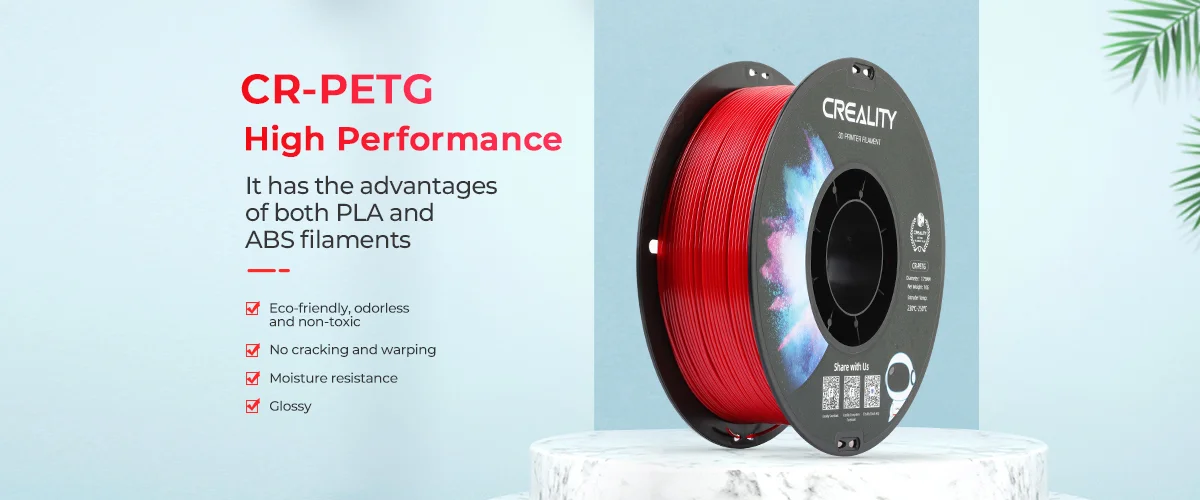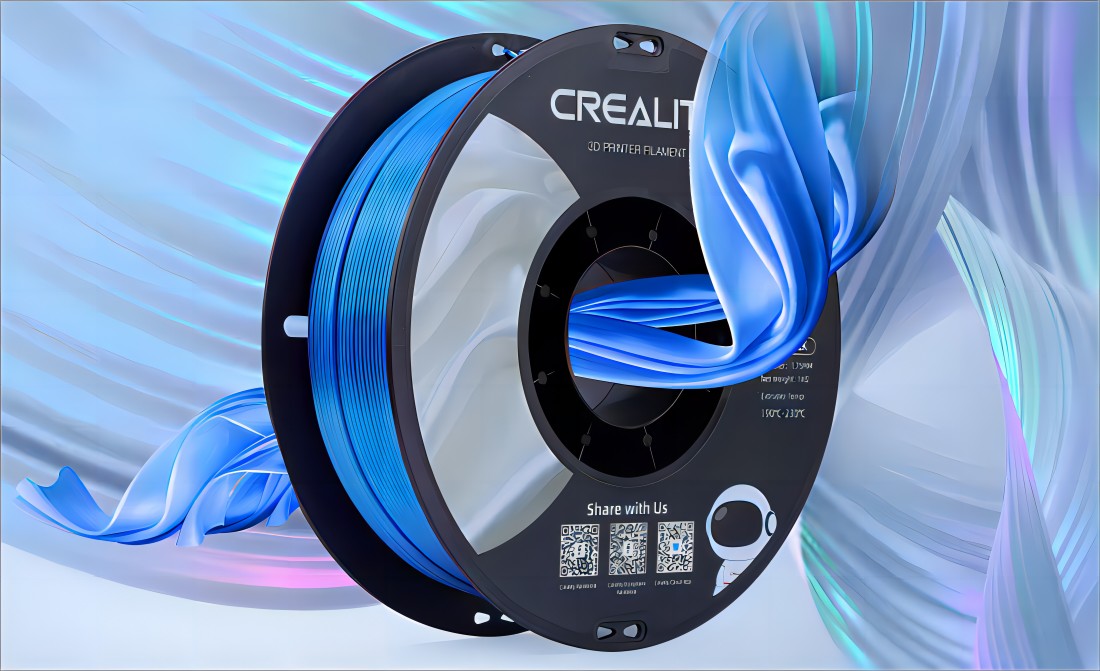3D printing has taken off in recent years with the majority of 3D printers now belonging to home users and hobbyists. The most popular and easy to use type of 3D printer is Fused Deposition Modelling (FDM) which uses different types of filament to build layers and create 3D printed items.
In this article, we’re going to look at two of the most popular and frequently used of these filaments, PETG and PLA. But what are they? Let’s first then take a closer look at what these two mainstays of 3D printing actually are and then answer some common questions about each filament.
What is PETG filament?
PETG (Polyethylene Terephthalate Glycol) is a durable, hardwearing polyester combination.
PET was first formulated in 1941 by the British scientists Dickson and Whinfield who patented their product for the manufacture of fibers. These fibers were intended to replace cotton as a source material for uses in textile manufacturing. It did however take until 1946 for PETG to be settled into the industry but it is still widely used today.
By 1952 the use of PET had expanded into food packaging in the form of transparent film and then in 1976 in the use of rigid drinks bottles. Drinks with low oxygen sensitivity were particularly best suited such as carbonated soft drinks, mineral water, and beer. The significance of this can’t be understated as it made PET the most used plastic in the world.
PETG itself is a copolymerization of the original PET. The addition of ethylene glycol (the “G”) made the PET less prone to crystallization and reduced its melting point. It also had a better thermal stability allowing it to be used to create flexible extruded parts as made by FDM 3D printers. For a step-by-step guide to dialing in your ideal PETG parameters, explore our complete Ender 3 PETG settings guide covering temperature tuning, adhesion fixes, and stringing solutions.
What is PLA filament?
PLA (Polylactic Acid) is the most commonly used type of filament material in the world of FDM 3D printing and is the go-to material for most users due to its ease-of-use, dimensional accuracy and wide availability. Most beginners in 3D printing use PLA for these exact same reasons and the range of colors and different types within the PLA genre is mind blowing.
Standard PLA is the most common but you can also find PLA+, silk, matt, rainbow, glow-in -the-dark and even color changing PLA to name but a few. PLA Has a low melting point or Glass Transition Temperature (GTT) so to become workable for 3D printing, you need a nozzle temperature of between 190-220ºC and a hot bed temperature of around 50-60ºC.
Let’s now move on to the comparisons between PETG and PLA. The first place to start would be the pros and cons of using either filament or the advantages of one over the other.
 What are the benefits of PETG over PLA?
What are the benefits of PETG over PLA?
PETG and PLA produce similar results in visual 3D printing terms but, as we’ve discussed, each one will feel and act differently.
Let’s look at the pros and cons of PETG filament:
Pros:
- Strength and resistance to impact
- Flexibility
- Thermal resistance
- Water resistance
- Food grade
- Good adhesion between layers when printing
- Minimal deformation when printing
- Resistance to wear and degradation
- Low odour
Cons:
- Can cause greater wear and tear to printer parts (nozzle, Bowden tube etc.)
- Higher printing temperatures
- Possible “stringing” issues when printing
- Scratches more easily
- Not ideal for supporting structures
- Can stick “too well” to build plates
- Can become brittle
The main benefits of PETG over PLA 3D printing filament therefore are:
- Water resistance
- Better rigidity, strength and resistance to impact
- Better resistance to heat
- Less deformation when printing
- Higher quality and lower odour
What are the disadvantages of PETG compared to PLA?
When comparing the two filaments in terms of print speed, PETG is more sensitive to this than PLA. This will mean that the extruded PETG filament may not stick to the layer below or the last strands if the print speed is too high. You may then find that PETG 3D prints end up with gaps or areas where it looks like under extrusion has occurred.
PLA adheres much better to the print bed and the previous printed layer due to its lower viscosity. You can therefore print using PLA filament at much higher speeds than PETG and still get good quality results.
This can be a disadvantage in PETG compared to model build speeds of PLA.
The lower speed and higher GTT can also lead to other problems with PETG filament as because it will print at a relatively high temperature, it makes it difficult to stop and control the filament flow. This then will lead to the appearance of over extrusion and oozing from the nozzle.
Why is PETG so hard to print with?
This is a common question that crops up from users who want to use PETG for its extra features but find it difficult to get successful prints.
The thing to remember with FDM 3D printing is that each type of filament that you use will require some changes to the nozzle and bed temperature, printing speeds, layer height etc. All these changes are necessary to ensure that you are getting the best from your 3D printer and the filament.
PETG has a different GTT than PLA and other filaments so adjustments need to be made to ensure the printer nozzle temperature is between 230-250ºC and the printer bed is 70-80ºC.
 What is PETG filament best used for?
What is PETG filament best used for?
As a printing material PETG has excellent flexibility, durability, and chemical resistance. This makes it an ideal choice for 3D printing enthusiasts who may want to try more than just model making.
That being said, it is still a good choice for those modellers who need good impact resistance and additional strength in their creations. It’s also great for models requiring snap together or movable parts.
The use of PETG filament in 3D printing is much the same as that of PLA; particularly if you are mainly interested in producing models for display etc. However, due to the properties of PETG mentioned previously, it is ideal for producing usable parts for machinery, medical devices, food containers and drinks receptacles.
The most common uses of PETG for the hobbyist 3D printing enthusiast could include:
- Cups – PETG is water resistant
- Lunch boxes – heat resistance can help prevent wilted sandwiches! However, check whether the PETG is rated “food safe” first
- Key fobs – good strength properties are ideal for an everyday item
- Outdoor plant pots – temperature resistance and water resistance combined
- Small handheld tools – pliers or handles for saws can be ideally suited
- Moving parts for models – snap together parts or those needed for items such as RC cars etc.
The list goes on and it is only limited by the creativity of the user!
What is PLA filament best used for?
PLA is a versatile and easy to use 3D printing filament which lends itself perfectly to creating models and prototypes.
The majority of models that you will see displayed by makers and designers will have been 3D printed using PLA filament. If you look at any of the thousands of models that you can find on Creality Cloud it’s likely that the suggested filament type is PLA.
There are of course other uses for PLA filament other than just for models and these would include various moving parts, brackets, shelves etc. However, in comparing PLA to PETG it’s worth looking at the pros and cons.
Pros
- Easy to work with:Low printing temperatures and easy to cut and sand in post processing
- Rigid and relatively strong:Can withstand a certain degree of impact
- *Good dimensional accuracy:Good quality PLA will be +/- 0.02mm or better
- Long shelf life: If stored correctly:PLA will last as long as you need it
(*Dimensional accuracy refers to the possible variation in diameter throughout a spool of PLA. The most commonly used diameter is 1.75mm so a dimensional accuracy of +/- 0.02mm means that some parts of the filament may be between 1.73 and 1.77mm)
Cons
- Low heat resistance: The low working temperature has a disadvantage when it comes to heat exposure when printed
- Blockages occur regularly:The low melting point again plays a part at slow printing speeds
- Requires cooling fans:Somewhere between a pro and con for this as most printers have fans anyway
- Filament can get brittle and break:If not stored correctly, the filament will harden and break. Vacuum storage is suggested and/or the use of a filament dryer
- Not suitable for outdoor use:PLA is vulnerable to water and UV light so won’t react well to being outdoors
PLA though remains the most versatile and widely used of all 3D printing filaments.
 Is PETG safe to print indoors?
Is PETG safe to print indoors?
Pretty much all FDM 3D printing filaments are safe to use and print indoors, but for some you may need to take extra precautions.
It’s always wise to use your 3D printer in a well-ventilated area but this in itself can then affect the quality of your prints. Any air or draught can cause prints to lift from the print bed and therefore an enclosure is the best option. You could make your own but if you want to get started right away then take a look at this enclosure made by Creality and designed specifically to fit standard to larger FDM printers. You could of course also buy a fully enclosed printer such as the Creality K1 which will help both with fumes and unwanted ambient temperature changes.
Is PETG good for 3d printing beginners?
PETG 3D printing filament is not necessarily the ideal filament for beginners and it would certainly be best to begin with PLA, at least until you feel competent. However, as with any filament, PETG just needs the right settings and printer setup and you shouldn’t really have any problems.
Beginners should certainly not be put off using PETG filament as its cost compared to PLA is still an affordable route into 3D printing. For instance, a standard 1KG roll of Creality Ender PLA filament is $19.99 compared to Creality CR PETG filament which is just $23.00 for a 1KG roll.
Why is my PETG not printing cleanly?
This takes us back to the issues we discussed earlier in this article and will no doubt be down to either the wrong temperatures being used or the wrong speed.
In order to get a “clean” print when using PETG filament, it’s advisable to print the first one or two layers at a lower speed than the rest of the print. This can be adjusted in the settings when you slice the model and will help with making a firm base and solid start to your 3D print.
Conclusion
So there we have it and hopefully this will have given you some useful insights into the differences between PETG and PLA 3D printing filaments. I will also have given you an idea of some of the advantages and disadvantages of each as well as some tips on how to best work with the filaments.
The main thing to remember is that both PETG and PLA are great filaments to use in 3D printing for the home user. You just need to buy quality filaments from Creality.com or a reputable supplier who sells Creality filaments.
